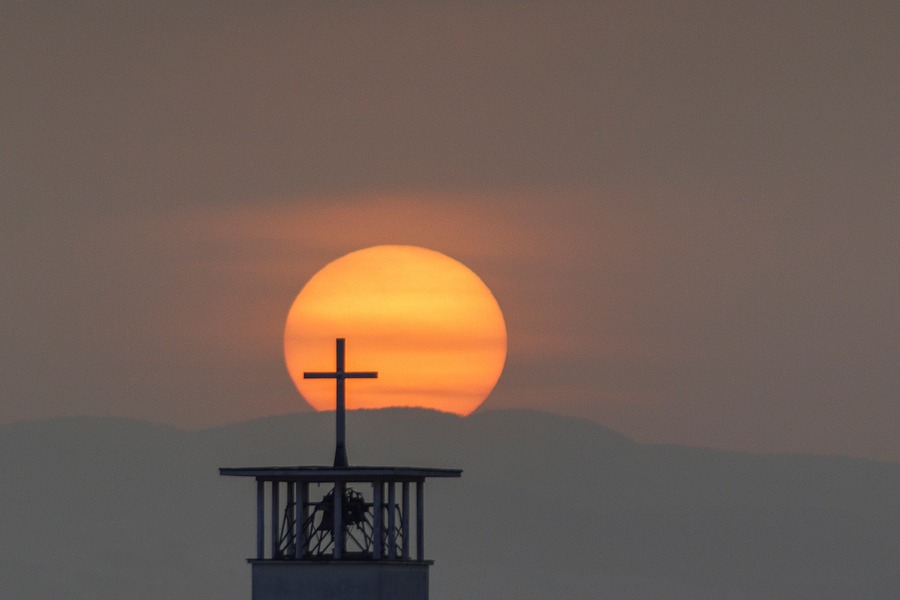
Summer Solstice
by Rev. Gabriel Baltes, O.S.B. | 06/22/2025 | A Message from Our PastorDear Parishioners,
As time rushes by as it seems to do the older one gets, last Friday, June 20, marked the official beginning of summer with the occurrence of the Summer Solstice at 10:42 PM. The solstice occurs twice a year, at winter around Dec. 21, and at summer around June 21. According to NASA, a solstice happens when one of the earth’s poles reaches its maximum tilt toward the sun. The word itself is derived from the Latin solstitium, meaning “sun stands still,” referring to the moment when the sun’s apparent path pauses before reversing its direction.
The summer solstice heralds the longest day of the year in the northern hemisphere when the earth’s tilt position is closest to the Sun giving us the most daylight. (The situation is reversed for the southern hemisphere where today is the shortest day of the year.) After the summer solstice, daylight gradually decreases until we arrive at the winter solstice.
This natural phenomenon has mystified and even frightened human beings throughout the centuries. For this reason many cultures have, and continue, to celebrate solstice occasions with unique traditions and age-old rituals that are designed to assist human beings in making the transition from one season to another. These “rites of passage” also recognize the primordial connection between the lives of finite mortal beings with the unstoppable and predictable life of the cosmos. History seems to demonstrate that life unfolds more peacefully and with greater ease when people live in harmony with the natural world instead of working against it.
The liturgical life of the Christian church is patterned on the recurring cycle of seasons that we experience in nature. This is evident in the commemoration of the Birth of St. John the Baptist on June 24th that traditionally has been called “Midsummer’s Day.” We know from the New Testament that John the Baptist, sometimes thought of as a relative of Jesus, was the final prophet who prepared the way for the coming of the Messiah. His message was succinct and direct, “He must increase and I must decrease.” (John 3:30) “He” is referring to Jesus and the “decrease” is in reference to his own life and ministry. It is as if John is saying, “I have done what I was called to do, namely announce the coming of Christ. I have fulfilled my mission, and now I must fade away so that full focus will be on the ministry of Jesus as God’s greatest revelation to the world.”
John’s message dovetails beautifully with what happens at the summer solstice when the light of the sun gradually decreases until it reaches the moment of the winter solstice near the time of Christmas when we celebrate the birth of Jesus. After the winter solstice the sun’s light increases just as the divine light of grace increased with the coming of Jesus Christ into the world. John decreases as Jesus increases. This brilliant coming together of nature with Christian theology expressed in liturgical rites, is a profound symbolic proclamation of what we believe at the heart of our faith, namely that eternal Son of God, the true light of the world, has come among us.
It is no surprise therefore, that many of the rituals associated with the birth of John the Baptist on June 24 were characterized by their use of fire. In Medieval times people lit fires in the streets. They hung lanterns outside their doors. They burned large fires on remote hillsides and rolled burning wheels of fire into their villages anticipating that this wheel would eventually make its way to a river of some body of water. These nighttime gatherings of fire drew people together were magical moments when the veil between this world and the heavenly world was thin so that the saints of heaven could mingle with the souls on earth.
Although we are perhaps more removed, than were our ancestors, from direct interaction with nature, we are still dependent on and subject to the cosmic powers of the creation. The occasion of the summer solstice and the solemnity of the birth of John the Baptist remind us of this. Both, the summer solstice and John’s birthday, ultimately direct us to God as we follow the call of the Baptist who declared that Jesus must increase and we must decrease.
Blessings,
Rev. Gabriel, O.S.B.
BACK TO LIST